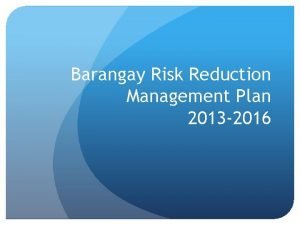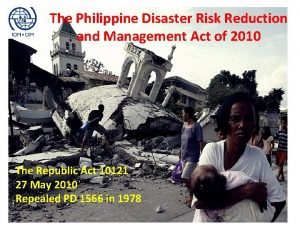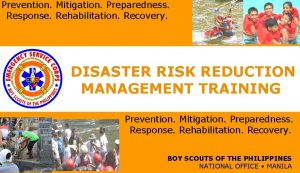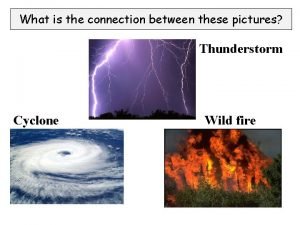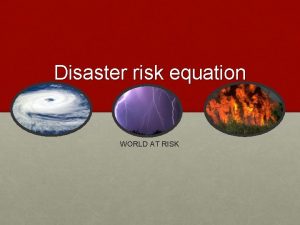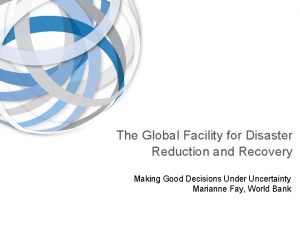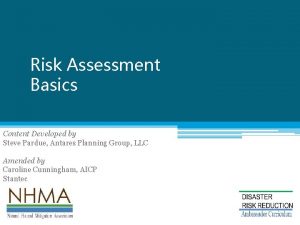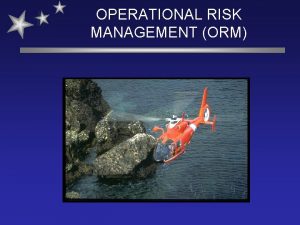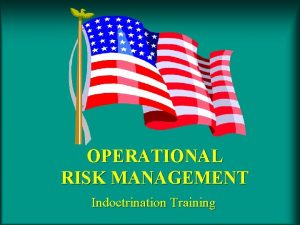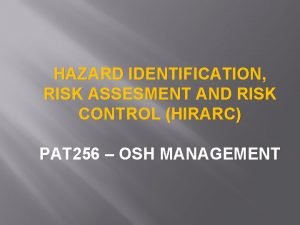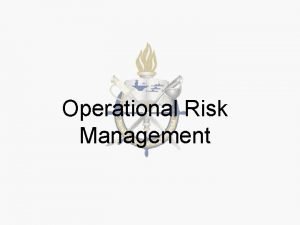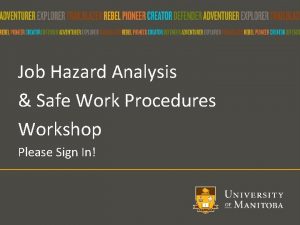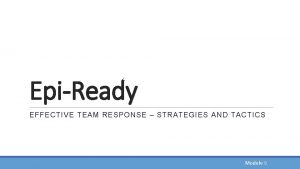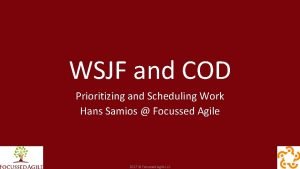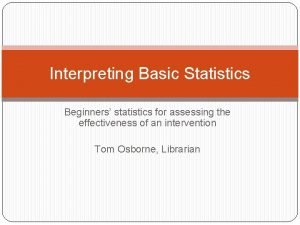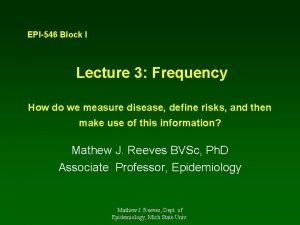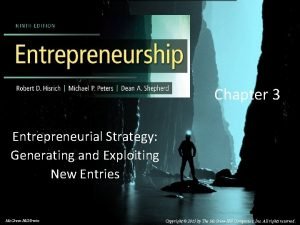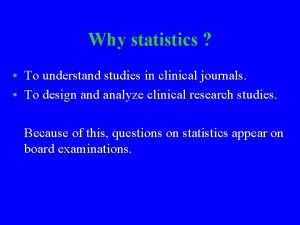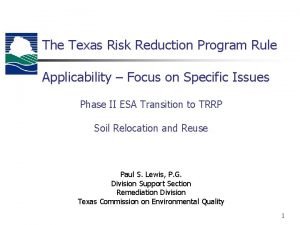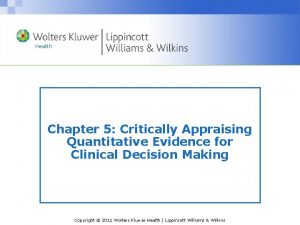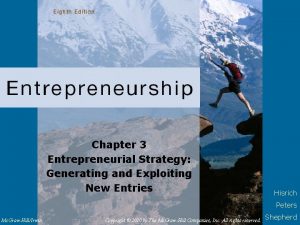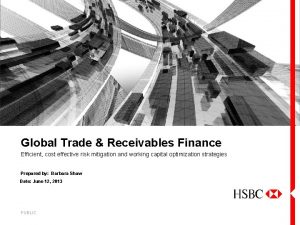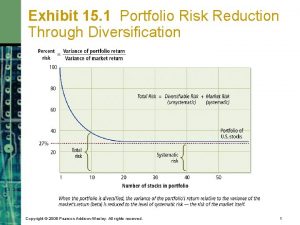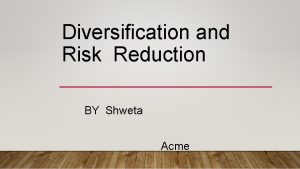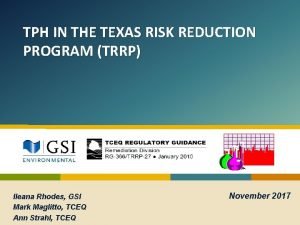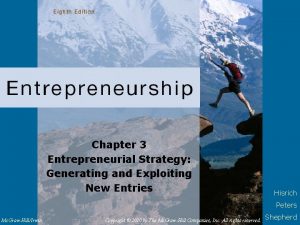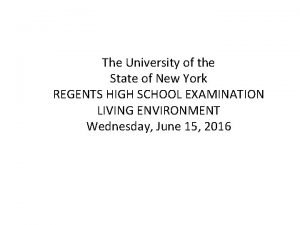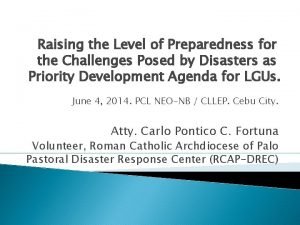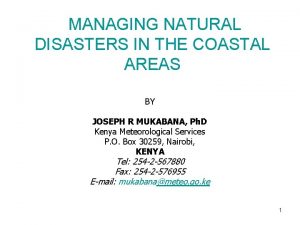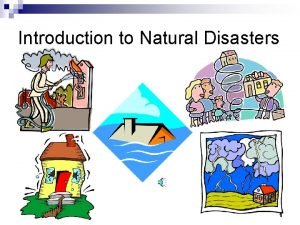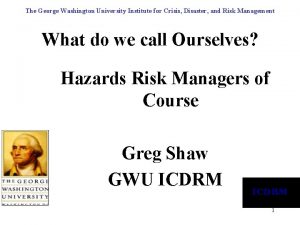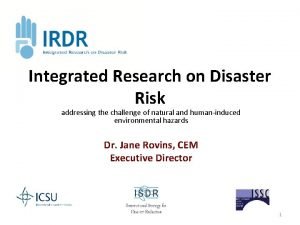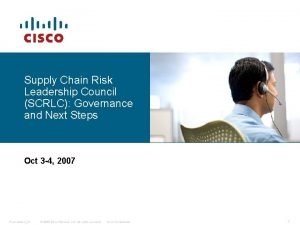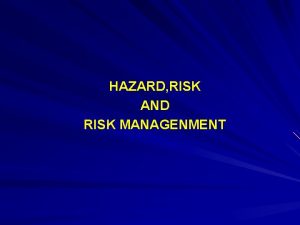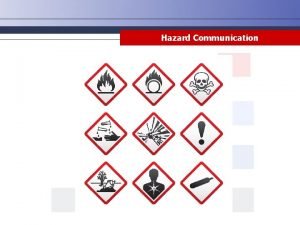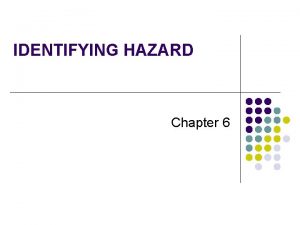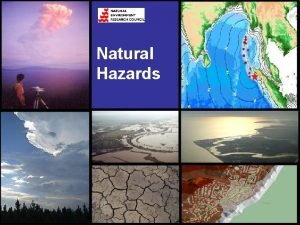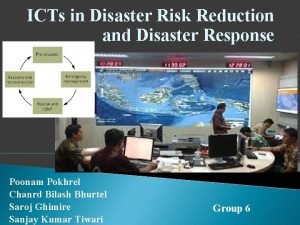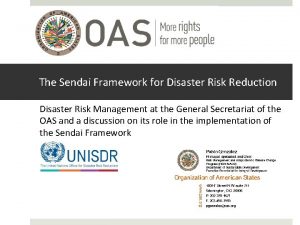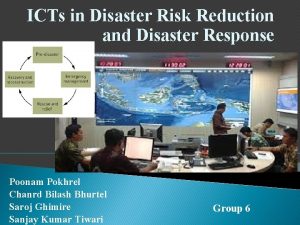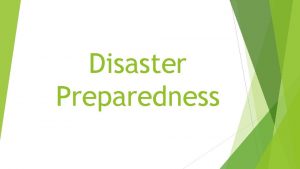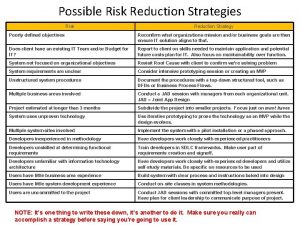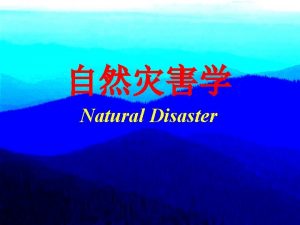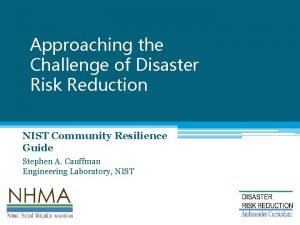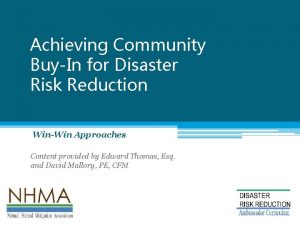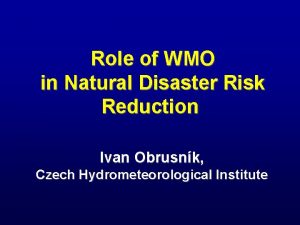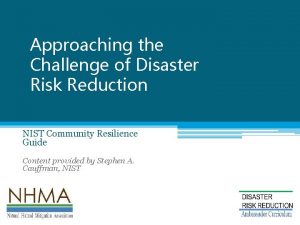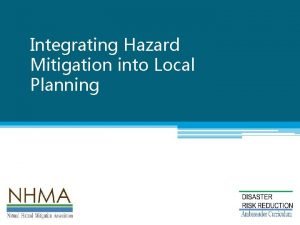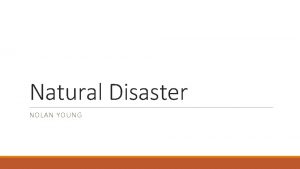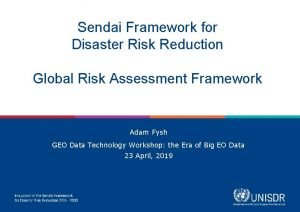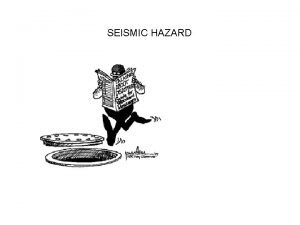Leadership for Disaster Risk Reduction Natural Hazard disaster











































- Slides: 43

Leadership for Disaster Risk Reduction Natural Hazard disaster risk reduction Association Content provided by: Donna Boyce, J. D. , NHMA Board Jim Mullen, NHMA Board DRAFT

2 Purpose of the Module This module examines the process of leading a community to achieve disaster risk reduction (DRR, ) focusing on how to identify and engage key stakeholders, and best practices for facilitating agreements and actions that will result in a safer community.

3 Learning Objectives 1. Describe the need for leadership throughout disaster risk reduction planning and implementation in a community 2. Discuss the role of leadership in identifying key stakeholders whose support is needed for success 3. Discuss how to approach and gain support from key stakeholders to achieve mutual interests in a safe community

4 Leaders for Disaster Risk Reduction • The Natural Hazards Mitigation Association strongly supports the goals and concept of reducing the toll of disasters through hazard mitigation - land use, building codes, and insurance • Accomplishing disaster risk reduction goals requires leaders who can find common ground a path forward among developers, environmentalists, and other community stakeholders

5 Leaders May be Chosen Based on What is Driving the Disaster Risk Reduction Effort Recent disasters Awareness of existing hazard risks and/or future climate change impacts Community land use planning Hazard mitigation planning Development proposals What else?

6 Leading a Community Disaster Risk Reduction Effort • Is an opportunity to serve by building awareness, engagement and coalitions as well as resilience • Careful planning and strategic partnerships are needed for both the process and outcomes

7 Community Framework for Disaster Risk Reduction • Mission statement, timeline and benchmarks • Planning team • Stakeholder engagement • Communication • Resources • Approval and implementation • Updates

8 Success Will Ultimately be Achieved by the Team Government Leaders Local/Regional Institutions of Higher Learning Local, State Elected officials Civic & Community Leaders Regional Representatives of Federal Agencies NGO Leaders

9 Key DRR Stakeholders – Funders • DRR planning and implementation will require public dollar financing • Buy-in from government leaders responsible for funding sources is vital ▫ State and local elected officials tasked with approval of plan or funding projects ▫ Regional representatives of Federal agencies providing funding

10 Key DRR Stakeholders – Local/State Officials • Local/state government officials enhance knowledge about the community and its needs • For example emergency management and/or planning, which may lead the DRR planning process • Other local offices that provide vital services also bring valuable knowledge: transportation, health & human services, housing, public works, education, economic development

11 Key DRR Stakeholders - Local Government • Including relevant local government offices brings the services provided by those offices to the planning table • This strategy also brings DRR considerations to those tasked with spending and project decisions • DRR can transcend the usual government office silos, providing added value to the community

12 Key DRR Stakeholders - Non. Governmental Organizations (NGOs) • Some NGOs perform governmental functions: ▫ Homeless services ▫ Emergency food assistance ▫ Special population housing ▫ Transportation or other services • Include leaders from these providers in DRR initiatives

13 Other Key Stakeholders • Regional or relevant philanthropy • Regional Planning Organization(s) • Local/state Chamber of Commerce • Major local employers, headquartered elsewhere • Local/regional healthcare systems & providers • Utilities

14 Roles for Key DRR Leaders and Stakeholders Planning Team leadership Ambassadors community engagement Working Group subject matter experts

15 Planning Team Having the right leaders on the planning team can garner support from the local community • Include representatives from an array of interests, organizations and perspectives • Early participation of key stakeholders garners buy-in through the plan approval and implementation phases • Representatives of local civic, business and faith-based organizations inform and influence plan adoption and project implementation

16 Ambassadors • Ambassadors representing the planning group or a working group may be able to engage local/ regional leaders, institutions of higher learning and/or other subject matter experts such as local Voluntary Organizations Active in Disasters (VOADs) or Long Term Recovery Group (LTRG) • Including local influencers creates ongoing engagement and DRR planning support

17 Working Group DRR planning and implementation requires expert resources that often exist within the community • Working groups can be convened to address particular issues, with limited time of performance and scope of service • Including subject matter experts gives volunteers with limited time but needed knowledge a way to participate • When consultants are used, limited engagement in working groups can make effective use of planning dollars

18 University Resources Institutions of higher learning can also be invaluable DRR resources • Bozeman MT’s DRR Planning Team includes University of MT, providing key resources and knowledge as a project working partner • The NYC Mass Transit Authority faced an 18 month closure of a subway line when NY Gov. Cuomo convened Deans of Cornell and Columbia Engineering Schools ▫ The team identified an engineering solution that does not require the subway line to close

19 University Resources (cont. ) • Educational Partnerships for Innovation in Communities (EPIC) partners higher education and communities to advance needs of communities while providing experience for students • College/Underserved Community Partnership Program (CUPP) EPA program that seeks to serve needs of small, underserved communities with student delivered technical assistance

20 Community Engagement in DRR • DRR requires cross sector efforts and approval from elected officials, other key stakeholders and local voters • Strong community engagement increases ▫ Legitimacy & support ▫ Ownership & buy-in ▫ Networks ▫ Better access to & use of local knowledge

21 How to Keep the Community Engaged in DRR • Hold planning team meetings • at a variety of times and locations to make it easy for the community and stakeholders to keep up with the process Conduct meetings and provide information in the languages of the community ▫ Check how the local government announces meetings as a guide • Create an official record of every step and make it available to the public

22 How to Keep the Community Engaged in DRR (cont. ) • Tailor DRR planning messaging to the interests of various community segments ▫ With and without knowledge of DRR ▫ Environmentalists ▫ Business people ▫ Faith based groups

23 How to Keep the Community Engaged in DRR (cont. ) Have a strong, strategic communication plan • Add communication to the project record to support project implementation • Share planning efforts, history and progress allowing newly engaged stakeholders to catch up • Make this information available online, and in print at local government offices and libraries • Announce activities in places where community convenes • Use flyers, text message reminders, QR codes and newly emerging data sharing

24 How to Keep the Community Engaged in DRR (cont. ) DRR planning updates and drafts are an opportunity for engagement with the community at large as well as strategic stakeholders • Make drafts available to the public in the same ways/languages/places as updates announced • Offer stakeholders, residents and other members of the public an opportunity to provide feedback on draft plans • Collect and review feedback, and address in subsequent iterations of the draft plan

25 DRR Planning Resources • FEMA’s Guide for Stakeholder Engagement • HUD DRR Toolkit • NIST Community DRR Planning Guide • NAACP DRR Planning Guide

More on Leadership for DRR • Getting the right people in the room: ▫ Identify their wants, needs, skills, abilities, Understanding ▫ Do they share a vision or cause? ▫ Do your homework – who needs to be part of the team

27 Approaching Leaders/Champions for DRR in the Community “When approaching government from outside government expect to get nowhere if you fail to appreciate and respect the challenges public officeholders are facing within their own electorate. ” ØJim Mullen, NHMA Board Member and former Director of Washington Emergency Management Division

28 Approaching Elected Officials Review who has supported the officeholder(s) that you are trying to enlist in disaster risk reduction efforts Find out if a particular officeholder is persuadable, and what resonates with them politically Too often a so-called “community sparkplug” is regarded with suspicion because of prior encounters, or a perception that the outsider is unconcerned with the overall issues that an elected officeholder must contend with

29 Approaching Elected Officials (cont. ) Some elected officials are anticipating a step up in the political world: this can be helpful in suggesting that showing “vision” in combatting known threats to the public and its economy is a sign of leadership It can also be a problem, because sometimes “risk avoidance” becomes a preeminent concern for the upwardly mobile politician

30 Approaching Elected Officials (cont. ) Officials concerned about reelection are likely to focus more on day-to-day issues without getting into trouble that has not already found them • Devise responses in advance to concerns about added costs, unlikely events, or even “there is nothing that can be done anyway”

31 Consider Recent Community History before “Storming the Castle” Have officials faced the problem before? • If yes, draw on that to suggest that preventive efforts might make recovery less challenging • If there is no institutional memory because the perceived threat has not occurred in a long time, there is no sense of urgency to mitigate something that theoretically might not occur on their watch Either way, the approach must be sensitive to the conditions that are present within the community, and the “pitch” should take into account the disposition of the decision makers

32 Approaching Public Employees Within the Government • There may be public employees that share the DRR advocates’ concerns and are in a position to influence the dialogue within government but could find themselves in a precarious position if they are viewed as not fully “on the team” in power

33 Approaching Public Employees Within the Government (cont. ) • These individuals can still be helpful, given constraints, by providing information and even guidance on: ▫ The questions that must be asked ▫ Data that can be requested and provided ▫ How to hit the sweet spot in approaching the elected officials, gaining their attention, and accelerating a discussion.

34 De-Conflict Competing Approaches Most people care about their children and their communities - it is the clash between competing approaches that creates conflict: • Help a developer understand that it is not just about additional cost • Help an elected official understand that the intent is not to make political life more difficult Underscore that while methods may be at issue, principles and values are probably similar

35 De-Conflict Competing Approaches (cont. ) • Lead key stakeholders to the conclusion that conflicting approaches can be reconciled to allow all sides to achieve something close to their desired outcome • Value clarification is a crucial part of this process • Leaders in the disaster risk reduction advocacy community, in the business community, in the political community have to identify what they value most in preserving and sustaining their social and economic equilibrium

36 Stakeholder Values How do we identify stakeholder values?

37 How Do We Identify Stakeholder Values? ü Listen at every stage ü Discuss ü Talk ü Do our homework

38 Use Basic Negotiation Principles • Build bridges-links • Make more friends and allies – many have very little knowledge or strong positive feelings about hazards • Again, most people care about their children and their communities Photo: Charter members of the Resilient Neighbors Network Steering Committee

39 Example: Messaging to those whose Primary Interest is Community’s Economy • Consider how devastating a natural event can, and unfortunately will, be to your community • Consider the growing vulnerability of our society, the economy, and the people We are not preparing properly for historic levels of disaster, or dealing with the uncertainties of future projections, climate variability, or climate change.

40 Example: Messaging to those whose Primary Interest is Community’s Economy • Stop making things worse Start the long difficult road to a safe sustainable future by ensuring safe development, not by preventing development.

41 A Useful Reference • By Roger Fisher and William Ury (1991, Second Edition has additional material by Bruce Patton) • Focuses on “Getting to Yes” through principled negotiations • From our perspective we want the principle to be…

42 Summary • DRR Ambassadors have the opportunity to serve by building awareness, engagement and coalitions to achieve DRR • Careful planning and strategic partnerships can improve both the process and outcomes of DRR efforts • Gaining support for DRR from formal leaders and influential citizens is critical

43 Thank You for Your Participation! • Questions and/or comments • Contact information Natural Hazard disaster risk reduction Association P. O. Box 170984 Boston, MA 02117 Email: nathazma@gmail. com www. nhma. info Website: Natural Hazard Mitigation Association
 Barangay disaster risk reduction management plan
Barangay disaster risk reduction management plan Pdrrm act of 2010 graphic organizer
Pdrrm act of 2010 graphic organizer Republic act 10121
Republic act 10121 Avoidance risk
Avoidance risk Credit risk market risk operational risk
Credit risk market risk operational risk Hazard vs disaster
Hazard vs disaster The disaster risk equation
The disaster risk equation Similarities of hazard and disaster venn diagram
Similarities of hazard and disaster venn diagram Global facility for disaster reduction and recovery
Global facility for disaster reduction and recovery Natural hazard mitigation association
Natural hazard mitigation association Deliberate orm
Deliberate orm Orm risk vs hazard
Orm risk vs hazard Hirarc table
Hirarc table Orm abcd process
Orm abcd process Difference of hazard and risk
Difference of hazard and risk Example of hazard and risk
Example of hazard and risk Sandman risk hazard outrage
Sandman risk hazard outrage Wsjf risk reduction
Wsjf risk reduction Interpreting relative risk
Interpreting relative risk Number need to treat
Number need to treat Risk reduction strategies for new entry exploitation
Risk reduction strategies for new entry exploitation Relative risk reduction formula
Relative risk reduction formula Texas risk reduction program
Texas risk reduction program Relative risk reduction formula
Relative risk reduction formula Risk reduction strategies for new entry exploitation
Risk reduction strategies for new entry exploitation Global trade and receivable finances
Global trade and receivable finances Risk reduction through diversification
Risk reduction through diversification Random diversification
Random diversification Trrp
Trrp Strategy
Strategy Natural disaster unit 9
Natural disaster unit 9 An individual eats a hamburger. which two systems
An individual eats a hamburger. which two systems Conclusion on natural disaster
Conclusion on natural disaster Explain natural disaster
Explain natural disaster Introduction natural disasters
Introduction natural disasters Introduction of natural disaster
Introduction of natural disaster George washington crisis management
George washington crisis management Integrated research on disaster risk
Integrated research on disaster risk Transactional leadership vs transformational leadership
Transactional leadership vs transformational leadership Adaptive leadership theory
Adaptive leadership theory Capable but cautious performer
Capable but cautious performer Supply chain risk leadership council
Supply chain risk leadership council Fspos
Fspos Novell typiska drag
Novell typiska drag
